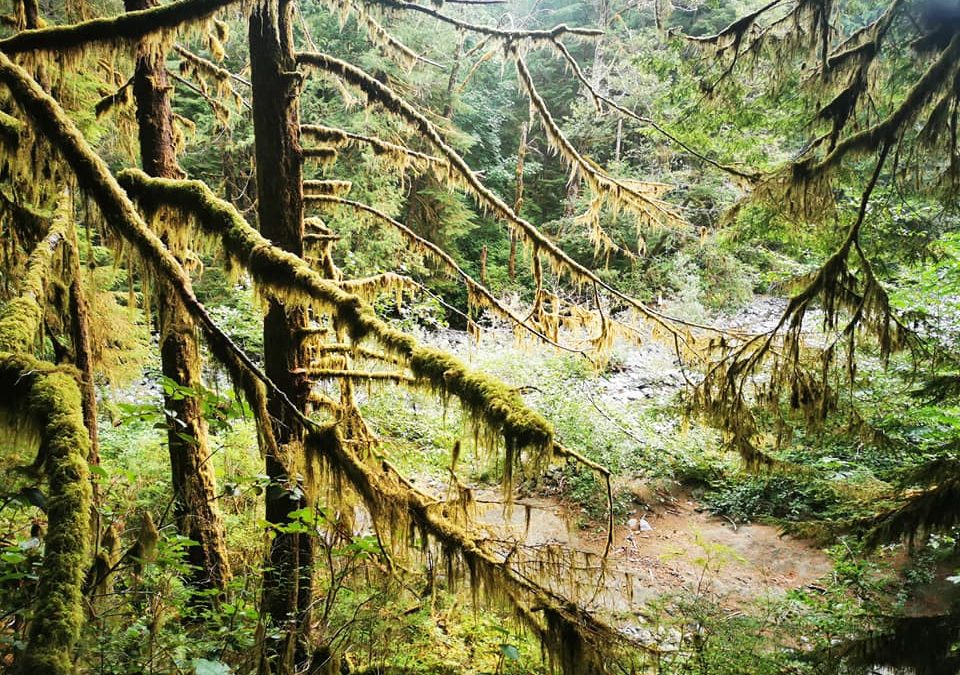Many endangered species inhabit the remaining old-growth forests that lie within and just outside Fairy Creek on the southern end of BC’s Vancouver Island, as well as nearby in areas like Eden, the Walbran, Bugaboo and Caycuse, say a group of scientists.
The biologists are angry that despite abundant findings of at-risk birds, extremely rare lichens and numerous other endangered species, approved cutblocks in these areas are likely to be logged within weeks, as soon as rains return and fire risk is reduced.
They’ve gathered the evidence – returning repeatedly to the area, despite being turned away numerous times by RCMP at arbitrary exclusion zones which the court recently characterized as “unlawful”. Protestors have been blocking loggers and road-building for the past year in some of the areas. For more than three months, RCMP have been enforcing the injunction awarded to logging company Teal Jones.
“Many rare and unusual species have been found in the Fairy Creek area, and road construction has already destroyed rare communities,” Dr. John Neilson explained. Old-growth forests are rich in biodiversity, and BC is considered more biodiverse than any other province or territory in Canada. Yet only 2.7 per cent of the province’s old growth remains. Many species can survive only in ancient forests. Fairy Creek is one of a few remaining fragments of temperate rainforest capable of growing huge trees, second only to redwoods in size.
Citizen scientist Tasha Lavdovsky found an exceedingly rare, blue-listed lichen in a cutblock, where logging was only stopped due to the blockades by Fairy Creek protestors.
Lavdovsky found most of the lichens in an approved and partially logged cutblock. It had likely been the largest population of this species ever found in BC, she said. The Old-growth Specklebelly lichen is unique to the west coast, and is a rare listed endemic species.
With Lavdovsky’s discovery, it is made clear that both government and Teal Jones did not fulfill their duty: BC Timber Sales guidelines specify that the lichen species requires the protection of a 200-metre buffer zone. Yet Teal Jones built a road right through the unique population. Lavdovsky found one of the lichen-covered trees marked with red falling-boundary tape.
“They’re dying now from too much sunlight,” she said.
The ecological importance of lichens is vastly underestimated, Dr. Loys Maingon said. Recent research has found that lichens may actually sequester even more carbon dioxide than the old-growth trees they live upon. They also neutralize acidic rainwater as it runs over them to the ground.
In response to the discovery, the scientists informed Teal Jones and government staff, and wrote an urgent letter to the ministers of Environment and Forests. They also made a formal complaint to the BC Forest Practices Board… So far, no response.
Dr. Royann Petrell has also found bird species in areas where government data did not report their presence. Yet she has been frustrated with the difficulty of conveying reports to government. Some species, for instance, will only be considered present by ministry staff if there is a minimum number, such as 25. This could mean that species in the gravest danger of being wiped out would already be considered non-existent, rather than receiving the protection they desperately need.
The BC government itself does not gather information on birds, Petrell found. It relies on data and surveys largely done by volunteers, or by scientists funded by grants or contracts, who usually rely on the help of volunteers.
At-risk species Petrell and others have seen and heard in recent months include Marbled Murrelets – sea birds that make solitary nests, only in old-growth forests – as well as Western screech owls (which don’t screech), Pygmy owls and other birds.
The scientists’ biological survey also turned up endangered Western toads, Northern red-legged frogs, little brown bats, and various plants.
Dr. Neilson, a past member of COSEWIC (the national scientific group assessing the status of endangered wildlife in Canada) said the Fairy Creek blockade “has bought time for citizen scientists to start to do the biological survey work that government and industry was obliged to do, but apparently did not.”
Kathleen Code, a Rainforest Flying Squad spokesperson, said: “Most of us trust that endangered species are protected by law in BC, but they’re not.
“Although there are government ‘guidelines’ requiring logging companies to complete a wildlife inventory and management plan before they log, in practice there is no penalty for inadequately prepared inventories and management plans. No penalty, in other words, for erasing habitat and killing endangered species.”
A more thorough inventory is still needed, the scientists say. This would consist of returning through different seasons, and better investigation of the central part of the Fairy Creek valley and watershed.
Yet so far the scientists have found 62 observations of 14 vulnerable species – when they’ve been allowed into the forest.
REFERENCES
– The iNaturalist Fairy Creek Project link:
https://www.inaturalist.org/projects/fairy-creek-research
(many bird sightings are also listed on ebird)
– how BC compares to other provinces in species protection:
“Failure to Protect: Grading Canada’s Species At Risk Laws” –
https://ecojustice.ca/wp-content/uploads/2014/08/Failure-to-protect_Grading-Canadas-Species-at-Risk-Laws.pdf
– Ancient Forest Alliance also made a complaint to the Forest Practices Board.
It took 3 years to investigate: https://thenarwhal.ca/bc-forests-old-growth-nahmint-river-watchdog/
